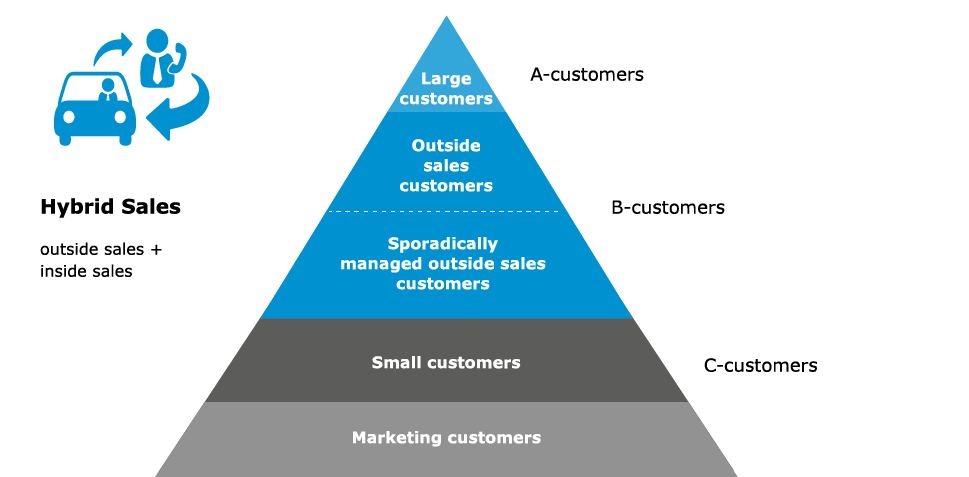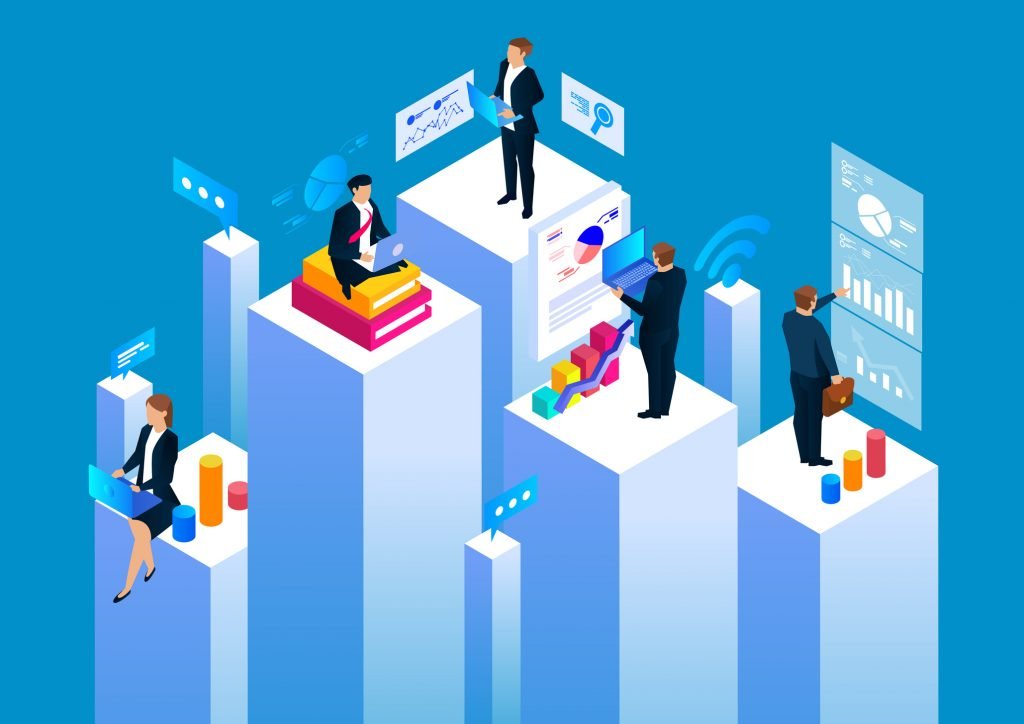Since B2B buyers are using more channels, B2B sellers must, too.

As COVID-19 restrictions fade, B2B businesses want nothing more than to get back to normal. But a recent Salesforce survey made it clear that getting back to pre-pandemic might not be possible nor desirable: 58% of reps believe their role has been permanently altered. The pandemic—and the required shift to remote, digital interactions between buyers and sellers—exposed major challenges to the old commercial approach. It also unearthed new opportunities.
According to research by McKinsey & Company, more than 90 percent of enterprises plan to sustain the changes made to their sales force structure over the past year to enable hybrid. And more importantly customers want to be served in this manner, and sellers want flexibility in how they work. To achieve these goals and optimize sales ROI, B2B sales organizations will need to continue their shift to a hybrid, remote-first model and embrace four proven success factors.
The Value of Digital
COVID-19 was a massive disruption, yet for commercial businesses, it accelerated changes that were already underway. Before the pandemic, top-performing organizations relied on digital channels to serve customers. In fact, many customers used digital self-serve solutions to research products and services before they ever interacted with a sales rep. But the commercial processes at many B2B organizations were still based on traditional sales methods—primarily oriented around field sales reps traveling to see clients in person.
More than just salespeople working out of their home offices, hybrid selling is a flexible, scalable—and frequently more profitable—way to reach buyers. It utilizes a combination of channels, including remote and e-commerce, to serve customers where they prefer to buy. Because of its omnichannel nature, it enables broader and deeper real-time customer engagement.
On the seller side, as of December 2021, more than 90 percent of B2B sales organizations viewed today’s B2B omnichannel reality as equally or more effective in reaching and serving customers than it was before COVID-19. This percentage has steadily increased from 54 percent since the beginning of the pandemic
Similarly, B2B buyers are increasingly comfortable turning to digital and online channels to meet their purchasing needs. In fact, B2B buyers use up to and sometimes more than ten channels, including online and digital, as part of any given purchase, which is double the number of channels five years ago, and up from seven channels only two years ago

While buyers have clearly been willing and able to engage in an ever-expanding omnichannel ecosystem, sales organizations have often not kept pace, wondering whether or how much buyers would actually spend in a fully remote or fully hybrid model. The answer is many buyers are willing to spend big on a single transaction using a remote or self-service model. Seventy-one percent of buyers are willing to spend more than $50,000 in a single transaction, and 27 percent would spend $500,000 or more.
Quite simply, digital needs to be at the forefront of every customer interaction. Sellers must offer engaging and intuitive e-commerce solutions to buyers across the entire customer experience, from initial research to the transaction to post-sale service. Throughout, sales and marketing leaders should use digital to better understand the performance of their teams and make smarter, data-driven decisions with respect to both improving execution and managing people.
Field sales are not dead, however. While digital is undoubtedly leading the way in sales calls and customer communication, there will be some need for in-person engagement in the years ahead. It’s critical for businesses to examine their customer base to understand where such interaction is still necessary and how it can work seamlessly with digital outreach.
Shift Field Sales Reps to Hybrid Interactions
The era of old-school “road warriors”—field reps who traveled to client sites 280 days a year—is over. In-person visits can be effective but, given recent advances in digital connectivity, they are also highly inefficient and often unnecessary. Some aspects of sales will likely always happen face-to-face with field reps, but COVID-19 showed the value of remote, digitally enabled interactions.
To shift from field work to hybrid interactions, companies must empower field sales reps with new digital tools, such as analytics-enabled CRM systems that can deliver insights from all sales channels. Additionally, artificial intelligence, already common in sales CRMs, should be used to suggest the next action in a sales cycle. Supplementary training and mobile tools can support these actions, showcasing opportunities across a pipeline.
Four Ways to Supercharge Hybrid Sales
Teams that outperform invest in systemic changes to improve remote sellers’ ability to sense and respond to customer needs by focusing on agility, customer insights, capabilities, and technology. Prioritizing the following four areas can enable other sales organizations to join the ranks of the outperformers.
Agility: Go remote where possible and where customers prefer it—but don’t abandon in-person sales completely Hybrid sales structures expand upon the pre-pandemic version of inside sales, creating an agile organization in which the majority of selling is conducted virtually and resources are deployed dynamically in response to customer opportunities. In-person engagement doesn’t go away entirely, but it is reserved for specific accounts and moments that matter, such as very large customers with complex needs, or for important opportunities, like buying a new product or solution, where buyers have signaled their preference for face-to-face engagement.
Insights: Harness customer and seller insights end-to-end
The need for sales representatives to log accurate and detailed information into customer-relationship management (CRM) systems does not disappear in a hybrid setting, but the efforts yield a higher return. When qualitative and manual inputs are combined with data from digital customer interactions, a richer, more timely set of actionable insights emerges. In a traditional, in-person-based sales model, many sales teams struggle to collect and analyze insights from the sales process. Qualitative information is especially challenging to collect, since it depends on individual representatives taking clear notes, faithfully logging calls and meetings, and recalling conversations accurately. In a hybrid world, gathering information and generating actionable insights becomes somewhat easier, since digital and automated interactions can be automatically recorded and analyzed. Automated analytics can track customer interactions over digital channels, generate specific recommendations, and make knowledge sharing less frictional. Digital enablement and tooling systems also allow representatives to log notes more quickly, through transcription of phone or video conversations, for instance.
Technology: Optimize tech for a remote-first environment
Outperforming sales organizations apply several strategies to support thoughtful adoption of new technology. They start by addressing critical pain points within their core sales processes. Most sales organizations know where their biggest productivity barriers are. At several sales organizations, for instance, remote sellers had to log into four different applications to get needed customer insights: one to find out who were the key influencers within the buyer’s organization, a second to explore the organization’s purchasing history, a third to access next-product-to-buy recommendations, and a fourth to view the strategic plan for the account. The issue was resolved with the creation of an integrated seller dashboard with a single sign-on. That relatively simple fix made a huge difference in seller productivity, allowing reps to spend 10 to 15 percent less time chasing down information and more time in front of customers.
Talent: Cultivate next-gen sales capabilities and attract more diverse talent by becoming a learning organization
As sales structures have evolved, so have traditional sales roles, such as field sales and inside sales, with many settling into a hybrid approach. A hybrid seller has the same set of responsibilities as a traditional field-based representative, but hybrid sellers use videoconferences, online chats, and the support of e-commerce to close deals, spending at least half their time working remotely, while field sellers spend most of their time in person with customers or traveling for customer meetings. Hybrid roles also allow for more diverse and inclusive organizations, according to a recent Forbes article, by removing barriers for talented people who were excluded from job opportunities in the past because they were unable to travel daily to an office, including primary caregivers, people with disabilities, and people facing economic housing limitations
Integration: Integrate Marketing and Sales Operations
Historically, sales, marketing, and service teams have been supported by their own operations teams, each utilizing different processes and platforms. In the future, these elements will have to come together. Ideally, this will occur through a high-level revenue operations role that creates and manages company-wide revenue and promotion strategies.
This kind of managerial change is not always possible for smaller companies, however. At a minimum, operations managers need to be aligned across B2B sales, marketing, and service teams, evolving from back-office sales support staff to strategic leaders tasked with increasing sales efficiency, marketing impact, and product value. Also, marketing and sales ops teams must use the same platforms with the same metrics, incentives, and planning rhythms. For example, if a company decides to invest heavily in a marketing campaign, that effort should be coordinated with sales operations in order to accommodate increased demand.
One of the biggest lessons from COVID-19 has been the success of remote, digitally enabled B2B sales. This development has not only resulted in greater effectiveness, but it has also opened the door to better customer experiences. For sales leaders, the challenge is to capitalize on the shift and resist the temptation to revert to old ways of working. As we look to the future, businesses of every size should invest in a true omnichannel sales model, while training their teams to manage longer-lasting—and more profitable—customer relationships.
About Growthline Partners
Growthline Partners specializes in assisting B2B companies implement the automated process and technology that frees up sales reps to invest their time and energy into other business development priorities, while efficiently tracking a lead’s level of engagement. For over 10 years Growthline Partners has assisted companies design, customize and implement their technology platforms and stacks based on Zoho or Salesforce software to turn them into high performance platforms that support their revenue acceleration and customer service strategies and initiatives.
About the Author
William Pickett is the Managing Director at Growthline Partners. He is a veteran of the technology and consulting industry and has held senior technology and management positions including Group Manager at AT&T Government Solutions and Senior Manager at Cap Gemini Ernst & Young. William has extensive knowledge of Salesforce & Zoho software and experience working with the financial, manufacturing and non-profit sectors.

